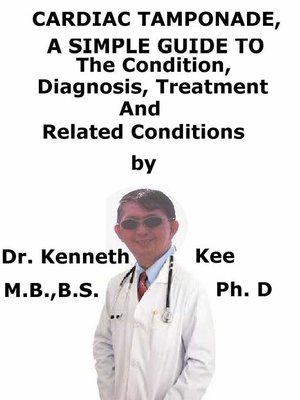Cardiac Tamponade, a Simple Guide to the Condition, Diagnosis, Treatment and Related Conditions
ebook
By Kenneth Kee

Sign up to save your library
With an OverDrive account, you can save your favorite libraries for at-a-glance information about availability. Find out more about OverDrive accounts.
Find this title in Libby, the library reading app by OverDrive.



Search for a digital library with this title
Title found at these libraries:
| Loading... |
This book describes Cardiac Tamponade, Diagnosis and Treatment and Related Diseases
Cardiac tamponade is a constant pressure on the heart that happens when too much blood or fluid collects in the space between the heart muscle and the outer covering sac of the heart.
Cardiac tamponade is caused by the collection of blood, fluid, pus, clots, or gas in the pericardial space, resulting in decreased ventricular filling and subsequent hemodynamic compromise
The fluid filled pericardial cavity prevents the heart ventricles from expanding fully reducing blood flow to the body.
The heart may stop pumping and death occurs.
Causes:
Pericarditis
Trauma and surgery
Cancer of breast and lung
Heart attack
Symptoms:
Cardiac tamponade may manifest with symptoms of fast breathing, breathing problems, anxiety, restlessness, fainting, chest pain, palpitations.
Signs
1.Distended neck veins,
2.Hypotension,
3.Tachycardia,
4.Tachypnea and
5.Hepatomegaly.
6.Muffled heart sounds.
7.Pericardial friction rub - evident in 50% but may be temporary.
Diagnosis
The diagnosis of Tamponade can often be difficult.
It can be diagnosed radiographically, if time permits.
The echocardiography often demonstrates an enlarged pericardium, and a chest x-ray of a large cardiac tamponade will indicate a large, globular heart.
The medical acumen of the heart specialist plays a larger part than imaging.
The echocardiogram is the test of choice to help confirm the diagnosis
Coronary angiography may be done
Pericardiocentesis; aspirate sent for culture and cytology.
Pericardial biopsy: may sometimes be needed
Treatment
The treatment of cardiac tamponade involves both pre-hospital and hospital care.
When the cardiac output is being affected, the peripheral tissues are being starved for oxygen.
As a first aid treatment, oxygen can be given.
Prompt diagnosis and treatment is the solution to survival with cardiac tamponade.
In advanced locations, pre-hospital teams do pericardocentesis,to drain the fluid, which can be life saving.
Cardiac tamponade is an emergency disorder that requires to be treated in the hospital.
The fluid around the heart must be drained as quickly as possible.
An intervention called pericardiocentesis that makes use of a needle to remove fluid from the tissue that surrounds the heart should be done.
This requires the insertion of a needle through the skin and into the pericardium and through the chest wall, and aspirating fluid.
Often, a cannula is left in place during resuscitation, after initial drainage so that the procedure can be done again if the need occurs.
IV Fluids are given to keep blood pressure normal until the fluid can be drained from around the heart.
Medicines that raise blood pressure may also help maintain the person alive until the fluid is drained.
Oxygen may be given to help decrease the workload on the heart by decreasing tissue demands for blood flow.
Pericardiocentesis (echocardiography-guided being the intervention of choice) is the definitive treatment but may be dangerous and not alleviate symptoms in cases of small effusions linked with constrictive pericarditis such as:
a.Malignancy,
b.Autoimmune conditions and
c.Viral infection.
Hospital Treatment:
1.Oxygen
2.Volume expansion to maintain adequate intravascular volume - small boluses work best
3.Increase venous return: bed rest with leg elevation.
4.Positive inotropic drugs: e.g., dobutamine.
5.Positive-pressure mechanical ventilation should be avoided because it may...






